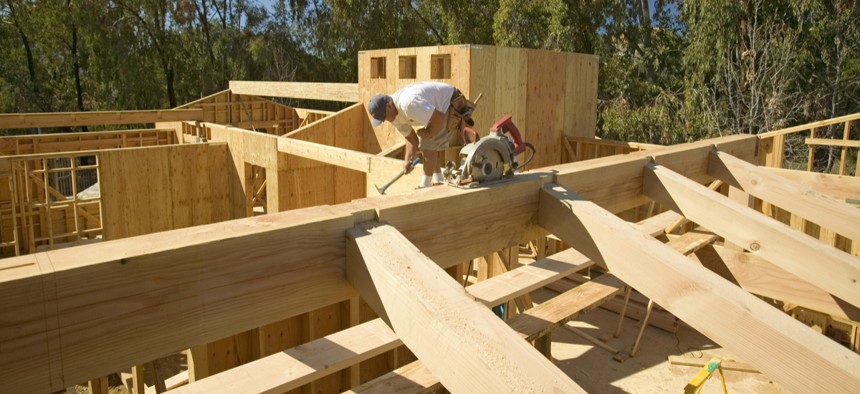A Different Kind of Housing Crisis

A carpenter hammers nails into the central beam while framing in southern California. Shutterstock
ANALYSIS | Many of the Trump administration’s most famous policies are impediments to affordable construction.
Donald Trump is right that the United States desperately needs more walls. He’s just wrong about their ideal dimension, purpose, and location. The U.S. need not spend tens of billions of dollars on a single barrier extending along the southern border between the United States and Mexico. Rather, what the suddenly wobbly U.S. economy could really use is millions of walls at 90-degree angles. I mean lots and lots of housing.
America’s last housing crisis was fairly complicated. Too many families bought houses they couldn’t afford, too many banks staked huge positions on housing debt, and when home sales, home prices, and on-time mortgage payments declined at the same time, the deck of cards came crashing down.
Today’s housing crisis is simpler: not enough supply. After the Great Recession, the adult population grew, but construction spending fell. In 60 years of record-keeping by the Federal Reserve Bank of Kansas City, home-building per household has never been lower.
Scarcity breeds inflation. So the predictable result of the housing crunch has been rising home prices, which have locked out young families from their piece of the American dream. The homeownership rate among late-20- and 30-somethings, which had held steady at around 50 percent since the 1970s, has plunged into the low 30s.
Housing is mostly a local issue. Construction is funneled through local zoning rules, demand is shaped by local jobs and local wealth, and local transportation routes determine the best location for new units.
But one nationwide impediment to more housing is a shortage of construction labor; young Americans don’t seem remotely interested in becoming cement masons or carpenters. That means the housing industry would vastly benefit from an influx of immigrants—precisely the thing Trump wants to stop at all costs with a giant border wall.
Immigrants already account for roughly 25 percent of construction jobs nationwide. They’ve pitched in to relieve construction shortages in some of America’s most housing-desperate areas. In California, the share of foreign-born workers in construction rose from 13 percent in 1980 to more than 40 percent today, according to a UCLA analysis. The construction trades with the highest labor shortages—brickmasons, roofers, and drywall installers—also tend to have the highest concentration of immigrant workers.
“It’s blatantly obvious that we have to find a labor supply to meet demand, or everybody is gonna pay a price,” said Phil Crone, the executive officer of the Dallas Builders Association. But trends are moving in the wrong direction. The number of immigrants entering the construction industry annually has fallen by more than 50 percent from its 2005 peak, according to a survey from the National Association of Home Builders. And it’s not going to recover quickly; not with visas down double-digits in Trump’s first two years in office.
Beyond the sphere of immigration, Washington could help matters by encouraging low-income-housing construction. That’s not happening. Under Barack Obama, Republicans blocked plans to fund the construction of new low-income units, and Trump’s White House has even threatened to slash funding for a public-private housing investment program called the Capital Magnet Fund. The Department of Housing and Urban Development isn’t in the building spirit, either; on the contrary, it has put forward a plan to triple rents for the poorest tenants.
Considering that the Trumps made their first millions in middle- and low-income units, one might think the president would leap at the opportunity to make home construction his presidential identity if only as a matter of habit, or familial loyalty. Instead, many of his administration’s most famous policies—its stringent stance on immigration, its attempts to slash hud funding, and its tariffs on construction materials—are all impediments to affordable construction.
And yet, stimulating the housing economy has never been more important, particularly for the White House. Stocks have been volatile for several months over concerns about global growth and rising interest rates. Other indicators, such as ISM, which measures manufacturing activity, are turning down. Trump is the least popular president in modern history, facing a battery of investigations and an incoming Democratic Congress that’s practically salivating over its broad subpoena powers. A recession could doom this presidency. To avoid one, Trump needs a strong housing sector.
As more economic indicators turn red, the president could save an endangered recovery—and, by extension, his uncertain reelection prospects—by renovating his wall rhetoric. #BuildtheWall? That’s so 2018. Mr. President, #BuildtheWalls.
Derek Thompson is a staff writer for The Atlantic, which originally published this article.
NEXT STORY: Medicaid ‘Buy-In’ Could Be a New Health Care Option for the Uninsured





